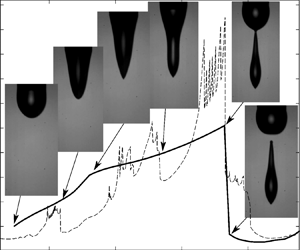Article contents
Modelling the electric microdripping from a needle
Published online by Cambridge University Press: 15 June 2021
Abstract

Droplet emission from an electrified meniscus in the microdripping regime has been investigated experimentally and numerically. In this regime, the meniscus of a low viscosity, high electrical conductivity liquid hanging from the tip of a metallic tube, oscillates when subjected to a high electric field. When the liquid is fed at a constant flow rate, and for a certain range of voltages, the oscillations are periodic and, in each oscillation, the meniscus develops a ligament that eventually detaches forming a single drop. Thus, this technique is a simple way to produce monodisperse droplets at relatively high frequencies, whose diameters may be one-tenth of that of the tube. The process, governed by a dimensionless flow rate  $q$ and an electric Bond number
$q$ and an electric Bond number  ${B_{E}}$, has been modelled as the axisymmetric motion of an inviscid meniscus of infinite conductivity, and compared against experiments. For moderate and high values of
${B_{E}}$, has been modelled as the axisymmetric motion of an inviscid meniscus of infinite conductivity, and compared against experiments. For moderate and high values of  $q$, the computed meniscus mean volume and oscillation frequency agree with the experimental results, although the volume and number of emitted droplets do not. An ultrafine electrospray emitted from the ligament's conical tip during part of the oscillation cycle is probably the cause of the disagreements. To tackle this, we combine the one-dimensional approximation of an electrified meniscus with experimental meniscus profiles to compute the electric field on the meniscus. Around the tip, this electric field turns out to be substantially smaller than the field computed by the model in the absence of the space charge, and agrees with the field induced by an electrospray emitted from a Taylor cone in air.
$q$, the computed meniscus mean volume and oscillation frequency agree with the experimental results, although the volume and number of emitted droplets do not. An ultrafine electrospray emitted from the ligament's conical tip during part of the oscillation cycle is probably the cause of the disagreements. To tackle this, we combine the one-dimensional approximation of an electrified meniscus with experimental meniscus profiles to compute the electric field on the meniscus. Around the tip, this electric field turns out to be substantially smaller than the field computed by the model in the absence of the space charge, and agrees with the field induced by an electrospray emitted from a Taylor cone in air.
- Type
- JFM Papers
- Information
- Copyright
- © The Author(s), 2021. Published by Cambridge University Press
References
REFERENCES
- 7
- Cited by



